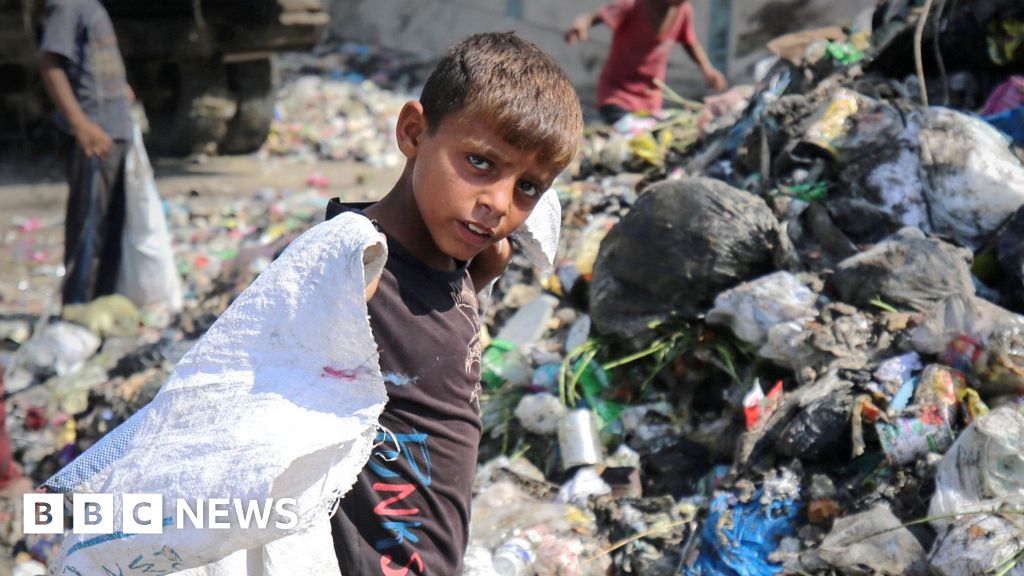Gaza residents live among rotting garbage and rodents

- Author, Yolande Knell
- Role, BBC News, Jerusalem
Throughout the Gaza Strip, in a landscape transformed by war, mountains of stinking garbage pose a serious threat to health and the environment.
“We have never lived next to garbage,” says Asmahan al-Masri, a displaced woman from Beit Hanoun in the north, whose house in Khan Younis is now a wasteland.
“I cry like any other grandmother when her grandchildren are sick and have scabies. It’s like a slow death. There is no dignity.”
According to the UN and humanitarian agencies working in the field of sanitation, an estimated 330,400 tons of solid waste have accumulated in the Palestinian territories over the past eight months.
Sixteen members of the Masri family share a tent in a camp near Al-Aqsa University that is swarming with flies and sometimes snakes. Stray dogs can roam menacingly nearby. All residents complain of the constant stench.
“The smell is very disturbing. I leave the door of my tent open so I can get some air, but no air comes out,” says Asmahan. “Only the smell of garbage.”
Some of the more than one million people who recently fled the Israeli military offensive in the southern city of Rafah were forced to live in open areas that had already been converted into makeshift garbage dumps.
“We looked everywhere for a suitable place, but we are 18 people with our children and grandchildren and we could not find anywhere else where we could stay together,” says Ali Nasser, who recently moved from his home in Rafah to the Al-Aqsa University campsite.
“The trip here cost us over 1,000 shekels ($268; £212) and now our finances are ruined. We have no work, no income and are therefore forced to live in this terrible situation. We suffer from vomiting, diarrhea and constantly itchy skin.”
Before the war, the years-long blockade of the Hamas-ruled Gaza Strip by Israel and Egypt had placed a heavy burden on basic services, such as waste disposal.
Strict restrictions on the entry of goods into the area for Israeli security reasons resulted in a lack of garbage trucks and equipment for sorting and recycling household waste and for its proper disposal.
Since the deadly Hamas attacks on October 7, the Israeli military has blocked access to the border area, which is home to Gaza’s two largest garbage dumps. One in Juhr al-Dik previously served the north, while another in al-Fukhari served the central and southern areas.
“We are experiencing a waste disposal crisis in Gaza that has worsened significantly in recent months,” says Sam Rose, planning director of the UN Relief and Works Agency for Palestinian Refugees (UNRWA).
Image source, Getty Images
Social media footage compiled by BBC Verify shows that the number of makeshift dumping sites has increased as people fled in waves to different cities. BBC Verify authenticated these sites in Gaza City, Khan Younis and Rafah from February to June this year.
A satellite analysis by BBC Verify had previously shed light on another aspect of the sanitation problems: it found that half of the water and sewage treatment plants in the Gaza Strip have been damaged or destroyed since Israel began its military operations against Hamas.
“You see huge puddles of grey-brown mud that people live around because they have no other choice, and you see huge piles of garbage. Either it is simply dumped in front of people’s houses, or in some places people are forced to move near the makeshift dumping sites that have been set up,” says Rose.
“People are literally living in garbage.”
The mass displacement is overwhelming local authorities, who often have to deal with damaged facilities due to ongoing Israeli bombardment and complain of a lack of staff, equipment and garbage trucks, as well as fuel to operate them.
In the Khan Younis municipality, Omar Matar expresses his regret at the appalling conditions in which people now live near Al-Aqsa University.
“These arbitrary dumps do not meet health or environmental standards. They do not prevent the spread of odors, insects and rodents,” he says.
“They were originally set up as an emergency measure due to the closure of the Sofa landfill (in al-Fukhari) until a solution to transport the waste there is found with international institutions,” he explains.
A spokesman for the Israeli military association Cogat told me that they are currently examining various solutions to the garbage problem in the Gaza Strip.
The United Nations Development Programme said it recently collected 47,000 tonnes of waste from central and southern Gaza and distributed 80,000 litres of fuel for clean-up efforts. But much more needs to be done.
With summer temperatures rising, aid organizations are once again warning of the health risks posed by so much garbage.
Yet desperation is driving many Gaza residents to take additional risks: looking for something to eat, use or sell.
“We’ve gotten used to the smell. Every day we come here together to look for cardboard boxes and other things to burn to make fire,” says Mohammed, one of a group of boys rummaging around in a garbage dump near Deir al-Balah, full of waste from aid packaging and rudimentary attempts at clearing land that has been hit by Israeli airstrikes.
Mazad Abu Mila, an internally displaced person from Beit Lahia, says he is looking for scrap metal to build a stove.
“We left all our money behind, our businesses, our cars, our livestock, our houses. Everything was left behind. This is the most dangerous thing for our health. Before, I would never have gone to a garbage dump, but now everyone comes here.”
Additional reporting by Paul Brown and Richard Irvine Brown of BBC Verify



